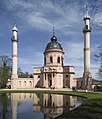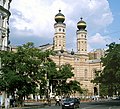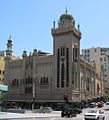Orientalizing architecture

As orientalisierende architectural structures are called to imitate the Oriental in shape and decoration designs or quote. It is a variant of historicism that can be seen in connection with orientalism in art .
Motifs of oriental architecture already appeared as set pieces in numerous palace gardens of the 18th century. Examples are the “mosque” in the park of Schwetzingen Castle , corresponding buildings in Eisgrub (Lednice) or Kew . Numerous " pagodas " also date from this period . The steam engine house in the form of a mosque, which was built around the middle of the 19th century, is one of this type of exotic accessories . The Moorish Andalusia , the Near and Far East and the Mughal architecture of India served as preferred models. As with the Egyptian fashion stimulated by Napoléon's Egyptian campaign , military and trade connections also played a role. The military superiority of the European powers and, especially in Central Europe, the elimination of the centuries-old threat from the Turkish wars triggered a freer and sometimes romanticizing approach to stylistic elements from eastern cultures. Orientalizing palace architecture created John Nash in Brighton with his Royal Pavilion (1815-1822), and a little later the British architect Edward Blore with the palace of Mikhail Semjonowitsch Voronzow in Alupka in the Crimea . In the late 19th century, plus the subject of growing commercial-style combination and the use occurs exotic architectures as an element of publicity , so when Yenidze -Zigarettenfabrik in Dresden , in the oriental Zacherlfabrik the raw material of Zacherl'schen Motte powder in Vienna (came from the Middle East), and at the Villa Crespi of a cotton industrialist with intensive trade contacts in the Arab region.
In general, in historicism, orientalizing décor was seen as part of the available stock of symbolically usable style elements and used for specialized building tasks, for example for synagogues , for which the “ Moorish style ” became typical for a time. Examples of this are the Semper Synagogue in Dresden, the Leopoldstädter Tempel in Vienna and the Dohány Synagogue in Budapest. The same applied to the ritual architecture of numerous Masonic temples built between 1870 and 1930 in the USA, namely for buildings by the Shriners .
The Moorish variant of historicism was of particular importance in Spain, where it could be seen as a direct reference to its own history (Neo- Mudéjar style or Neo - Moorish style ). Also Antoni Gaudí was inspired, especially in his early works, the Moorish heritage, such as the Casa Vicens or the Episcopal Palace of Astorga . In Andalusia, the Neo-Mudéjar style became particularly popular in the exhibition projects of 1929, typically in the Plaza de España (Seville) and the Gran Teatro Falla in Cádiz . Around 1900, many residential buildings in Madrid received Neo-Mudejar decor. The Las Ventas bullring and the office building of the Diario ABC newspaper date from the 1920s .
Orientalizing decor was also used in the entertainment industry and for instruction, especially at world exhibitions, in amusement parks and bars (e.g. Vauxhall (London), Tivoli (Copenhagen) and Bataclan (Paris)). The use of exotic styles in large cinemas from the silent film era (see for example Grauman's Chinese Theater , Grauman's Egyptian Theater ), or the Fox Theater in Atlanta was very popular . Orientalizing architecture was also used in zoological gardens. Numerous coffee houses and kiosks were designed in the Moorish style, again with regard to the oriental origin of the drink.
literature
- Exhibition catalogs of the exhibition cycle Exotic Worlds - European Fantasies , Stuttgart 1987, including above all:
- Stefan Koppelkamm : Exotic Architectures in the 18th and 19th Centuries , also published as: The Imaginary Orient: Exotic Buildings of the 18th and 19th Centuries in Europe , Ernst & Sohn, Berlin 1987 ISBN 3-433-02274-7
- Nadine Beautheac, Francois-Xavier Bouchart: L'Europe exotique , Chene, Paris 1985
- Jean-Marcel Humbert: L'égyptomanie dans l'art occidental , ACR, Paris 1989
- William D. Moore: Masonic Temples: Freemasonry, Ritual Architecture, and Masculine Archetypes University of Tennessee Press 2006, ISBN 1-57233-496-7, ISBN 978-1-57233-496-0
- David Naylor: Great American Movie Theaters , The Preservation Press, Washington DC, 1987
- Ross Thorne: Picture Palace Architecture in Australia , Sun Books Pty. Ltd., South Melbourne, Australia, 1976
Web links
Examples in the picture
The “Red Mosque” in the Schwetzingen Palace Gardens was never intended as an Islamic house of worship. It was built as a garden folly between 1779 and 1793.
The pumping station for the Great Fountain in Sanssouci Park was built by Ludwig Persius from 1841 to 1843 "in the style of Turkish mosques with a minaret as a chimney" .
Moorish kiosk of the Paris World Exhibition 1867 in the park of Linderhof Palace .
Moroccan house , bought on behalf of Ludwig II at the Paris World Exhibition in 1878 and also built in Linderhof.
The Vorontsov Palace on the Crimea, built in 1828–46 , south front
The Great Synagogue on Dohány Street, Budapest was inaugurated in 1859.
The Spanish Synagogue in Prague was decorated with rich ornaments in the Moorish style from 1882–83.
The Zacherlfabrik in Vienna is one of the rare examples of a commercially motivated orientalizing historicism in European architecture (built between 1888 and 1892)
Orientalism in the amusement park: Pagoda in Tivoli in Copenhagen .
Café Orient was a gastronomic establishment in Wiesbaden (built in 1899, demolished in 1964)
The synagogue in Sofia , an impressive orientalizing sacred building, built in 1909.
Carpet sales room in the Tietz department store, Düsseldorf , around 1910
The Tripoli Shrine Temple (Milwaukee) opened in 1928.
The Forum Theater in Melbourne, Australia (opened 1929)
The former city hall of Sarajevo (built 1892–94), burned down in 1992, renovated until 2014
Formerly a royal pleasure palace in Stuttgart, today part of the Wilhelma zoo
Residential house with facade in the Moorish style in Frankfurt am Main on the Anlagenring



















